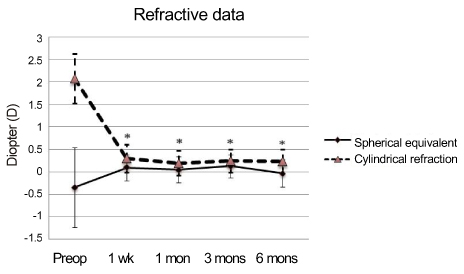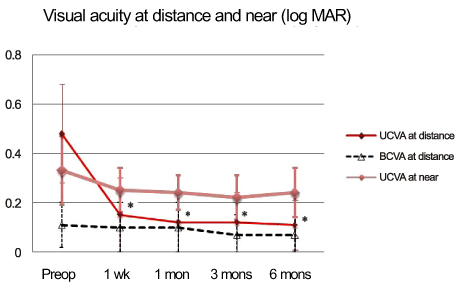J Korean Ophthalmol Soc.
2012 Dec;53(12):1742-1748. 10.3341/jkos.2012.53.12.1742.
The Effects of Laser Refractive Surgery for Correcting Residual Refractive Error after Implantation of ReSTOR(R) Multifocal IOL
- Affiliations
-
- 1Department of Ophthalmology, Saevit Eye Hospital, Goyang, Korea. glaucoma@hanmail.net
- 2Anyang Seoul Eye Clinic, Anyang, Korea.
- KMID: 2216385
- DOI: http://doi.org/10.3341/jkos.2012.53.12.1742
Abstract
- PURPOSE
To evaluate the clinical effects of excimer laser refractive surgery on eyes with residual refractive error after implantation of ReSTOR(R) multifocal intraocular lenses.
METHODS
We retrospectively reviewed the medical records of 10 eyes of 6 patients who had undergone cataract surgery with implantation of multifocal intraocular lenses. Photorefractive keratectomy (PRK) (5 eyes) and laser-assisted in situ keratomileusis (LASIK) (5 eyes) was performed on 10 eyes with residual refractive error.
RESULTS
After cataract surgery and before laser surgery, the mean spherical equivalent (SE) was -0.34 +/- 0.89 D and the mean astigmatism was 2.08 +/- 0.55 D. Six months after laser surgery, the mean SE was -0.33 +/- 0.30 D (p = 0.354) and the mean astigmatism was 0.23 +/- 0.28 D. The changes in astigmatism between paired preoperative and postoperative values were statistically significant (p < 0.0001). At 6 months after surgery, uncorrected distance visual acuity significantly improved to 0.11 +/- 0.10 (log MAR) (p < 0.0001) There were no significant changes in the best corrected distance visual acuity and uncorrected near visual acuity (p = 0.073, p = 0.100).
CONCLUSIONS
On the basis of predictability and stability, excimer laser surgery appears to be a clinically useful procedure to correct residual refractive error after implantation of ReSTOR(R) multifocal intraocular lenses.
Keyword
MeSH Terms
Figure
Reference
-
1. Kohnen T, Allen D, Boureau C, et al. European multicenter study of the AcrySof ReSTOR apodized diffractive intraocular lens. Ophthalmology. 2006. 113:584.e1.2. Toto L, Falconio G, Vecchiarino L, et al. Visual performance and biocompatibility of 2 multifocal diffractive IOLs: six-month comparative study. J Cataract Refract Surg. 2007. 33:1419–1425.3. Alfonso JF, Fernández-Vega L, Baamonde MB, Montés-Micó R. Prospective visual evaluation of apodized diffractive intraocular lenses. J Cataract Refract Surg. 2007. 33:1235–1243.4. Blaylock JF, Si Z, Vickers C. Visual and refractive status at different focal distances after implantation of the ReSTOR multifocal intraocular lens. J Cataract Refract Surg. 2006. 32:1464–1473.5. Lee HS, Park SH, Kim MS. Clinical results and some problems of multifocal apodized diffractive intraocular lens implantation. J Korean Ophthalmol Soc. 2008. 49:1235–1241.6. Yun J, Ahn K, Lee DH, et al. Spheric, aspheric ReSTOR intraocular lens: three-month results and preoperative clinical factors influencing patient's satisfaction. J Korean Ophthalmol Soc. 2010. 51:14–21.7. Kang EC, Kim EK, Kim TI. Comparisons of visual acuity, spherical aberration and contrast sensitivity among spheric, aspheric ReSTOR®, and Crystalens HD® Lenses. J Korean Ophthalmol Soc. 2011. 52:1275–1280.8. Kim SM, Kim CH, Chung ES, Chung TY. Visual outcome and patient satisfaction after implantation of multifocal IOLs: three-month follow-up results. J Korean Ophthalmol Soc. 2012. 53:230–237.9. Kim S, Kim MS. The study on target refraction to improve visual quality in patients implanted with multifocal IOL. J Korean Ophthalmol Soc. 2012. 53:223–229.10. Hayashi K, Hayashi H, Nakao F, Hayashi F. Influence of astigmatism on multifocal and monofocal intraocular lenses. Am J Ophthalmol. 2000. 130:477–482.11. Chiam PJ, Chan JH, Aggarwal RK, Kasaby S. ReSTOR intraocular lens implantation in cataract surgery: quality of vision. J Cataract Refract Surg. 2006. 32:1459–1463.12. Hayashi K, Manabe S, Yoshida M, Hayashi H. Effect of astigmatism on visual acuity in eyes with a diffractive multifocal intraocular lens. J Cataract Refract Surg. 2010. 36:1323–1329.13. Lee AC, Qazi MA, Pepose JS. Biometry and intraocular lens power calculation. Curr Opin Ophthalmol. 2008. 19:13–17.14. Jendritza BB, Knorz MC, Morton S. Wavefront-guided excimer laser vision correction after multifocal IOL implantation. J Refract Surg. 2008. 24:274–279.15. Alfonso JF, Fernández-Vega L, Montés-Micó R, Valcárcel B. Femtosecond laser for residual refractive error correction after refractive lens exchange with multifocal intraocular lens implantation. Am J Ophthalmol. 2008. 146:244–250.16. Muftuoglu O, Prasher P, Chu C, et al. Laser in situ keratomileusis for residual refractive errors after apodized diffractive multifocal intraocular lens implantation. J Cataract Refract Surg. 2009. 35:1063–1071.17. Kuo IC, Reviglio VE. Wavefront-guided refractive surgery after multifocal lens implantation. Curr Opin Ophthalmol. 2009. 20:255–259.18. Piñero DR, Ayala Espinosa MJ, Alió JL. LASIK outcomes following multifocal and monofocal intraocular lens implantation. J Refract Surg. 2010. 26:569–577.19. Kim JH, Lee JW, Chung JL, et al. Combined implantation of monofocal and multifocal intraocular lenses in senile cataract surgery. J Korean Ophthalmol Soc. 2009. 50:1632–1638.20. Fernández-Vega L, Alfonso JF, Montés-Micó R, Amhaz H. Visual acuity tolerance to residual refractive errors in patients with an apodized diffractive intraocular lens. J Cataract Refract Surg. 2008. 34:199–204.21. Woodward MA, Randleman JB, Stulting RD. Dissatisfaction after multifocal intraocular lens implantation. J Cataract Refract Surg. 2009. 35:992–997.22. Maloney RK, Chan WK, Steinert R, et al. Summit Therapeutic Refractive Study Group. A multicenter trial of photorefractive keratectomy for residual myopia after previous ocular surgery. Ophthalmology. 1995. 102:1042–1052. discussion 1052-3.23. Ayala MJ, Pérez-Santonja JJ, Artola A, et al. Laser in situ keratomileusis to correct residual myopia after cataract surgery. J Refract Surg. 2001. 17:12–16.24. Kim P, Briganti EM, Sutton GL, et al. Laser in situ keratomileusis for refractive error after cataract surgery. J Cataract Refract Surg. 2005. 31:979–986.25. Kuo IC, O'Brien TP, Broman AT, et al. Excimer laser surgery for correction of ametropia after cataract surgery. J Cataract Refract Surg. 2005. 31:2104–2110.26. Leccisotti A. Secondary procedures after presbyopic lens exchange. J Cataract Refract Surg. 2004. 30:1461–1465.27. Alió JL, Tavolato M, De la Hoz F, et al. Near vision restoration with refractive lens exchange and pseudoaccommodating and multifocal refractive and diffractive intraocular lenses: comparative clinical study. J Cataract Refract Surg. 2004. 30:2494–2503.28. Macsai MS, Fontes BM. Refractive enhancement following presbyopia-correcting intraocular lens implantation. Curr Opin Ophthalmol. 2008. 19:18–21.29. Schraepen P, Vandorselaer T, Trau R, Tassignon MJ. LASIK and arcuate incisions for the treatment of post-penetrating keratoplasty anisometropia and/or astigmatism. Bull Soc Belge Ophtalmol. 2004. 292:19–25.30. Golas L, Manche EE. Dry eye after laser in situ keratomileusis with femtosecond laser and mechanical keratome. J Cataract Refract Surg. 2011. 37:1476–1480.31. Leccisotti A. Bioptics: where do things stand? Curr Opin Ophthalmol. 2006. 17:399–405.
- Full Text Links
- Actions
-
Cited
- CITED
-
- Close
- Share
- Similar articles
-
- Refractive Outcomes of FineVision Intraocular Lens Implantation after Myopia-correcting Refractive Surgery and Retinal Detachment Vitrectomy
- A Case of Corrected Residual Refractive Error after Cataract Surgery with the Sulcoflex Piggyback IOL
- Postoperative Refractive Error in Combined Operation of Vitrectomy and Intraocular Lens Implantation
- Comparison of Prediction Accuracy of Four Intraocular Lens Power Calculation Formulas for Presbyopia-Correcting Intraocular Lens
- The Difference in Post-operative Refractive Error between In-the-bag and Sulcus Intraocular Lens Implantation





